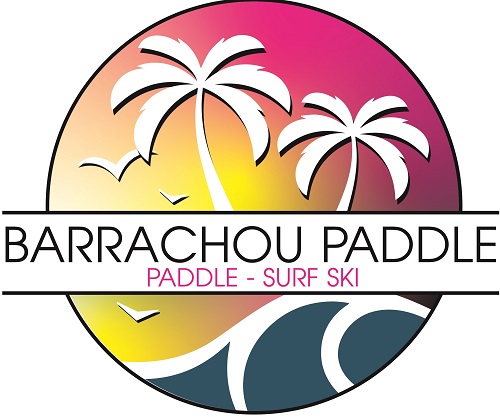Planning a Safe and Successful SUP Session: Tides, Wind & Waves Explained
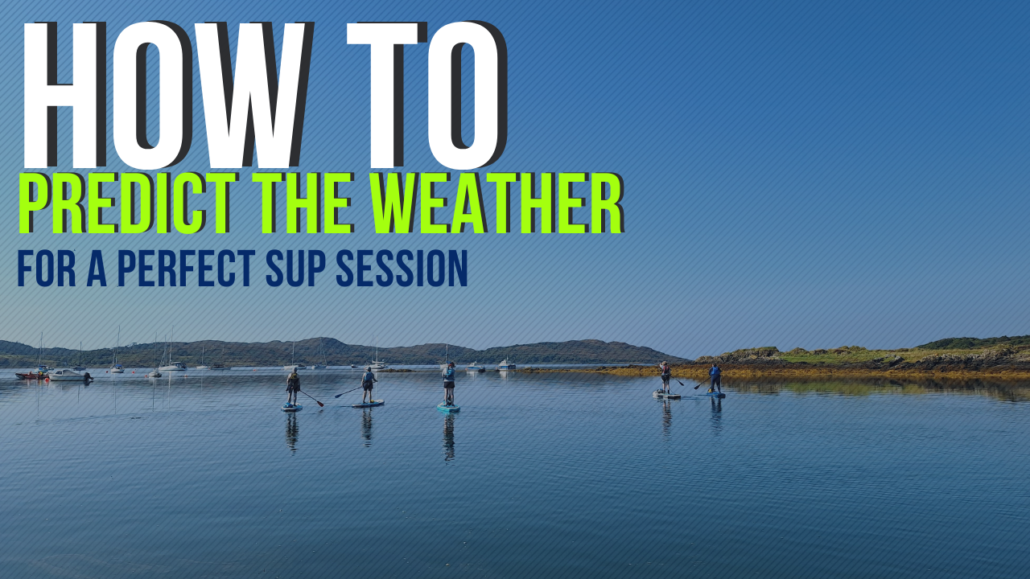
The stand-up paddleboarding (SUP) industry is booming. With more people than ever taking to the water, it’s clear that SUP is one of the most accessible water sports out there. Whether you’re cruising on a calm lake, exploring the coastline, or catching your first wave, the basic paddleboarding techniques—like paddling and turning—can be learned in just one session.
But the real challenge lies in planning your paddle: reading forecasts, understanding tides, and predicting conditions. These are the skills that separate a good day on the water from a potentially dangerous or frustrating one.
In this guide for beginner SUP paddlers, we’ll dive into the three essential factors that can make or break your session:
-
Tides
-
Wind
-
Waves
Let’s explore how each of these elements affects your SUP experience, and how you can use this knowledge to plan smarter paddleboarding adventures.
1. Understanding Tides for Paddleboarding
If you’re paddleboarding in the UK, Ireland, or anywhere along the North Atlantic coastline, tidal changes can be significant. For example, the Severn Estuary in the UK has the second-largest tidal range in the world, after the Bay of Fundy in Canada.
What Are Spring and Neap Tides?
Tides follow a monthly cycle:
-
Spring tides (stronger currents, larger range) occur during full and new moons.
-
Neap tides (weaker currents, smaller range) occur during quarter moons.
Check local tide tables to find out the exact times of high and low tides.
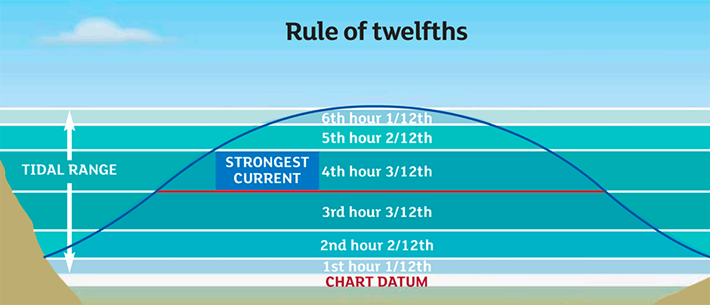
Rule of Twelfths: How Fast the Water Rises
The rule of twelfths helps estimate how water levels change between tides. For example, if the tidal range is 10 metres, then:
-
1st hour after low tide: 1/12 of the range (? 0.83m)
-
2nd hour: 2/12 (? 1.66m)
-
3rd hour: 3/12 (? 2.49m)
-
Total rise after 3 hours: ? 5m
Spring tides will exaggerate this rise, meaning stronger tidal currents—which can either help or hinder your session.
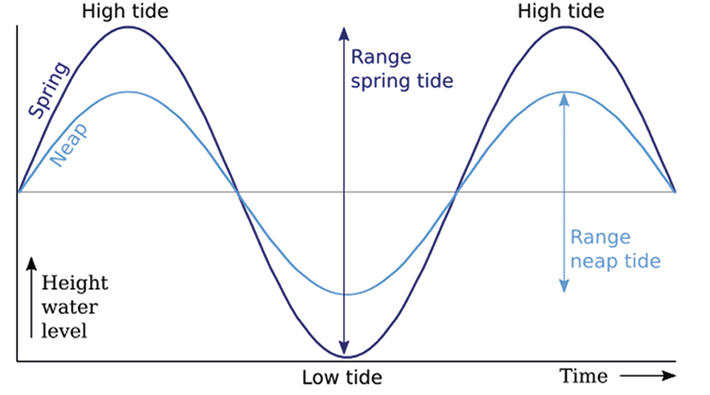
Why bother with this? If the phase of the moon is in spring tides, then you will see that the value in the rule of twelfths at mid-tide is bigger than at neap tides. This is when we need to plan our paddle session wisely. Paddling up the estuary at this point would be fruitless, you will be paddling against the current, a strong current, again depending on your location.
Using Tidal Curves and Apps
We live in the age of smartphones—no need for complicated maths. Use online tidal curves to visually understand how the water will move. These curves are:
-
Steeper during spring tides (faster water movement)
-
Flatter during neap tides (slower water movement)
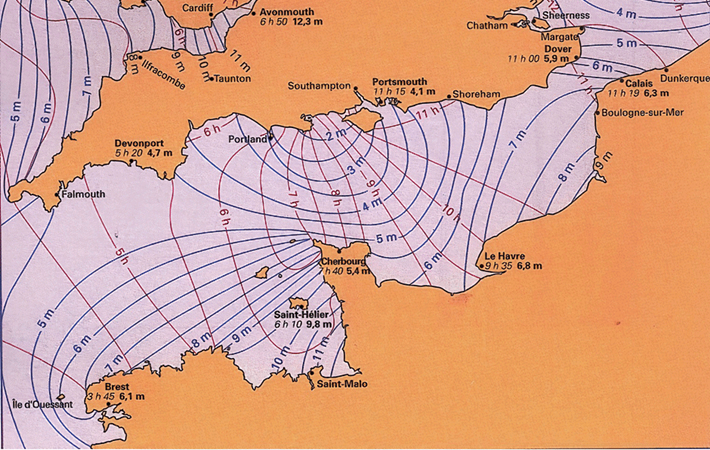
Location Matters
Different areas experience different tidal patterns:
-
Diurnal tides: One high and one low tide per day (rare in the UK)
-
Semi-diurnal tides: Two highs and two lows per day (common in the UK)
Coastal morphology (estuaries, peninsulas, bays) greatly influences tide strength and range. For example, Southampton experiences a double high tide due to the tidal flow around the Isle of Wight.
The morphology of the UK for example, with channels, estuaries, peninsulas means that as the tide pushes up channels, some tidal ranges get bigger. For example, the Bristol Channel has one of the biggest tidal ranges in the UK, with the Solway Firth second.
Interestingly, Southampton has a famous double tide at spring tides and a very rapid decrease in-depth during the ebb. The double high tide in the Solent is caused by the incoming sea to take two routes around the Isle of Wight.
How Tides Affect Your SUP Session
-
SUP surfing: Neap tides often mean longer sessions with gentler water movement.
-
Touring or long-distance SUP: You’ll need to time your paddle with the tide, ideally heading out with the flow and returning with it.
2. Wind: Your Best Friend or Worst Enemy in SUP
Wind is one of the most unpredictable—and influential—factors in stand-up paddleboarding. Whether you’re SUP surfing, touring, or cruising on a lake, wind can shape the session entirely.
Safe Wind Speeds for Paddleboarding
-
Under 10 knots: Ideal for beginners and most flatwater SUP sessions.
-
10–15 knots: Manageable for intermediate paddlers and great for downwind SUP sessions.
-
Over 15 knots: Generally not safe for beginners, especially with offshore winds.
Golden Rule: Avoid paddling in offshore winds over 10 knots unless you are very experienced.
Offshore vs. Onshore Wind
-
Offshore wind: Blows from land to sea. Can flatten surf but is dangerous if you drift too far out.
-
Onshore wind: Blows from sea to land. Can create choppy water but offers a safer fallback.
-
Cross-shore wind: Sideways wind—manageable with experience and good swell.
Use Wind Forecast Apps
Top wind forecast apps for SUP paddlers include:
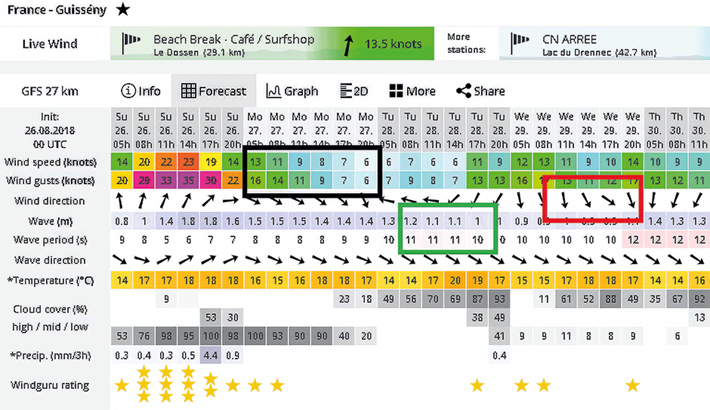
-
Windguru – Easy-to-read colour charts (light blue = calm, purple = storm).
Using Windguru is simple; it has a user-friendly light blue to a dark purple gradient. Generally speaking, blue means that the conditions are flat, calm ranging to purple, which means storm conditions typically.
When looking at the Windguru model, it is essential to note that the data we are given as a free user is less accurate than the data for a fee-paying customer. But the free data service is still a great tool.
Windguru also gives the wind direction, an essential element; this is the difference between being blown offshore or dealing with choppy conditions. Again, the strength of wind depends on your level, type of paddle session and location that you are paddling.
Reading Windguru is simple; it colour-codes conditions to make it even user-friendly. Light blue to green is generally OK for paddlers, pink to purple is a storm, unless you are planning a downwind session then this is not the best conditions to be paddling.
Whatever value you are seeking, it is a rule of thumb to have the wind with you for the end part of your journey or race, when energy levels are more depleted.
All use predictive models that don’t account for local geography, so always combine forecasts with local knowledge.
3. Waves and Swell: Reading the Surf Forecast
Whether you love or fear them, waves are a crucial part of paddleboarding in coastal areas. For beginners and SUP surfers alike, understanding wave conditions is vital.
Wave Height
-
Under 0.5m: Great for beginners and flatwater paddlers.
-
0.5m–1m: Ideal for confident paddlers and beginner SUP surf conditions.
-
1m+: Excellent for experienced SUP surfers.
Wave Period
This refers to the time between waves:
-
Under 10 seconds: Wind swell – shorter, choppier waves
-
10–12 seconds or more: Ground swell – long-travelled waves, smoother and more powerful
For SUP surfing, look for 1m+ height and 10+ seconds wave period for epic conditions.
Wave Direction
Know your coastline:
-
Facing west or southwest? You’ll benefit from Atlantic swell.
-
Facing north or northeast? You’ll likely have sheltered conditions, ideal for flatwater paddling.
Choose your session based on exposure or protection from the swell depending on your goals.
Summary: SUP Planning Checklist for Beginners
Check the tides – Use tide tables or apps to understand timing and strength
Look at the wind forecast – Choose calm or helpful wind conditions
Read the wave report – Know your skill level and match it to the wave size and period
Plan your session around your energy levels – Always finish with the tide or wind in your favour
Use trusted apps – Try Windguru, MSW, Windy, or Wisuki for up-to-date conditions
Respect local knowledge – Forecasts don’t replace real-world experience
Want to Learn More? Join the Wild Women SUP Symposium!
Looking to build your confidence and skills on the water? Come along to the Wild Women SUP Symposium—a welcoming and empowering event where we dive deeper into forecasting, safety, planning, and skills to help make every SUP session your best.
Spots are limited, so don’t miss out!
